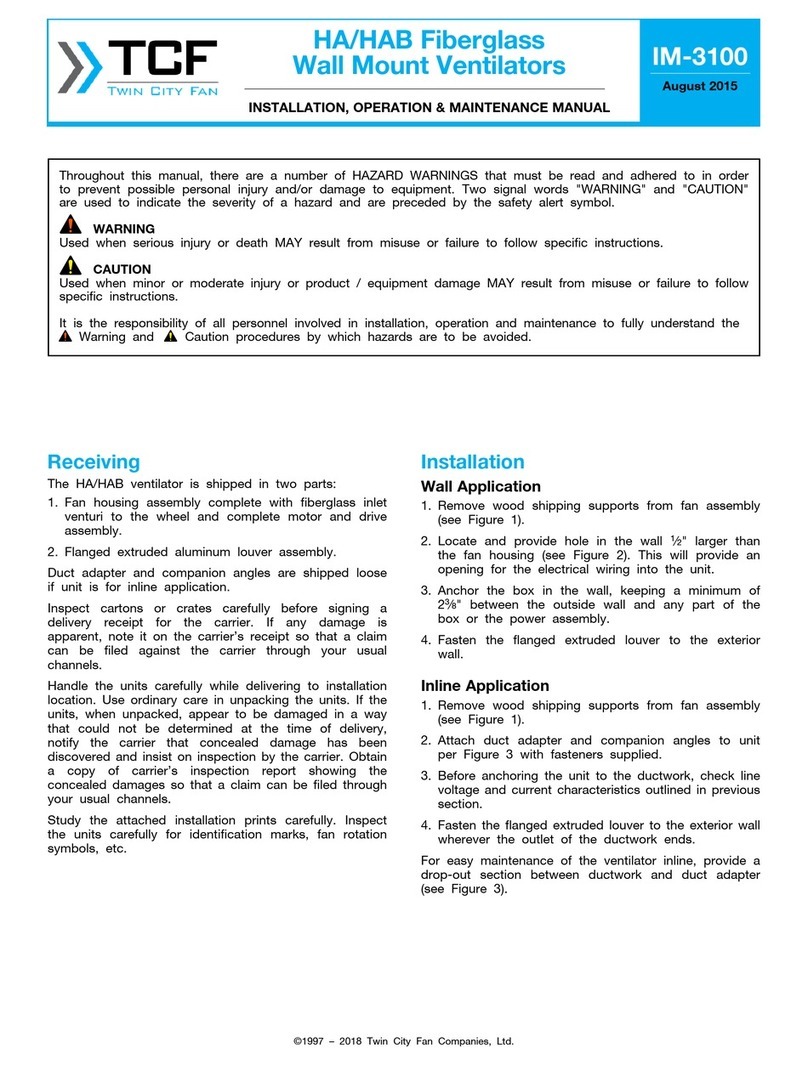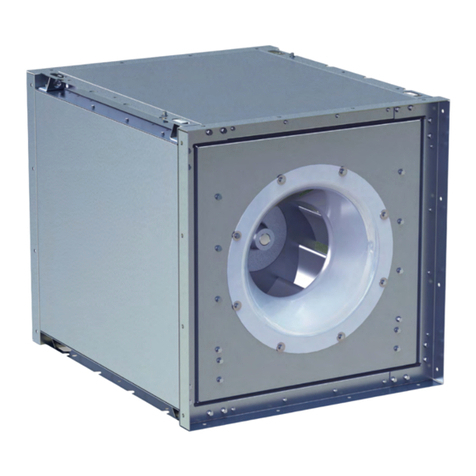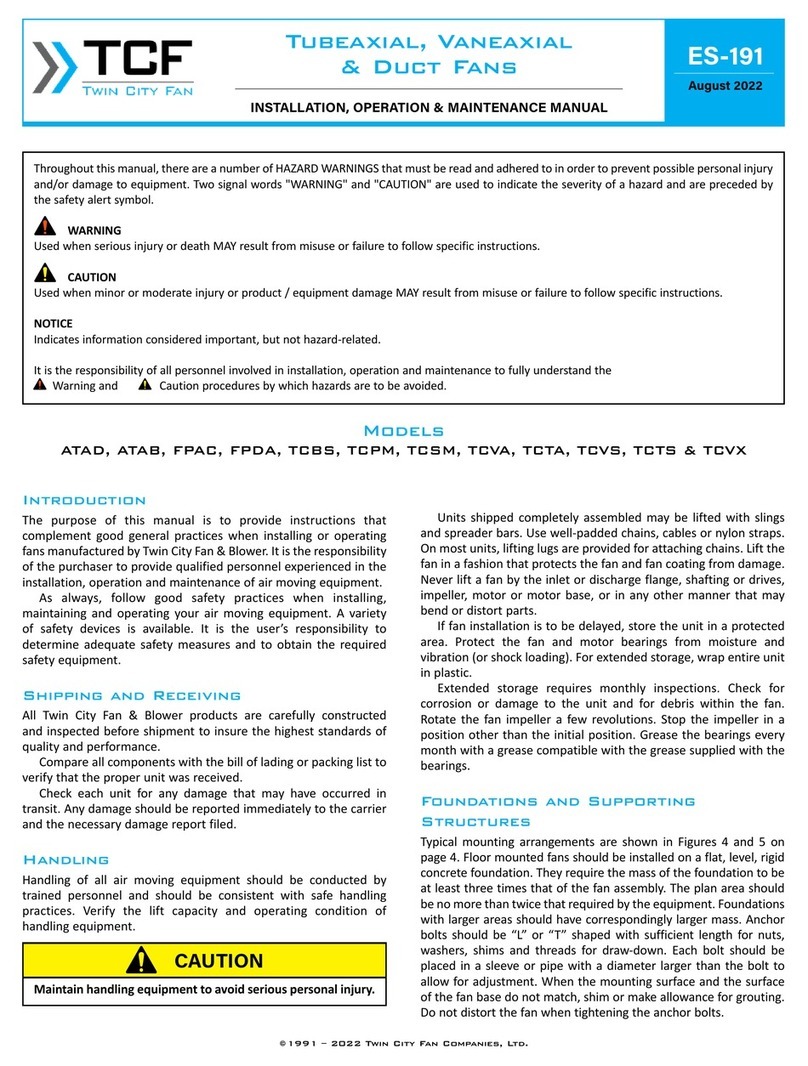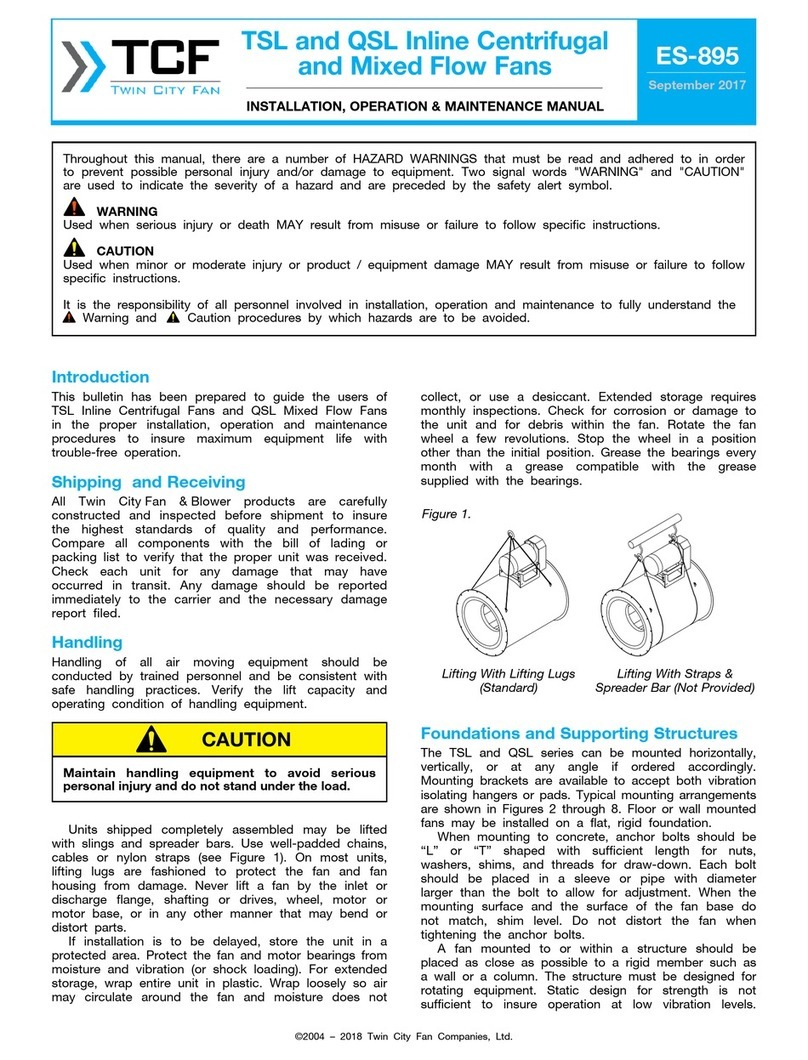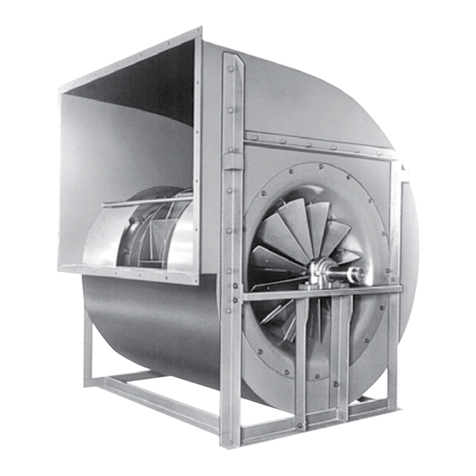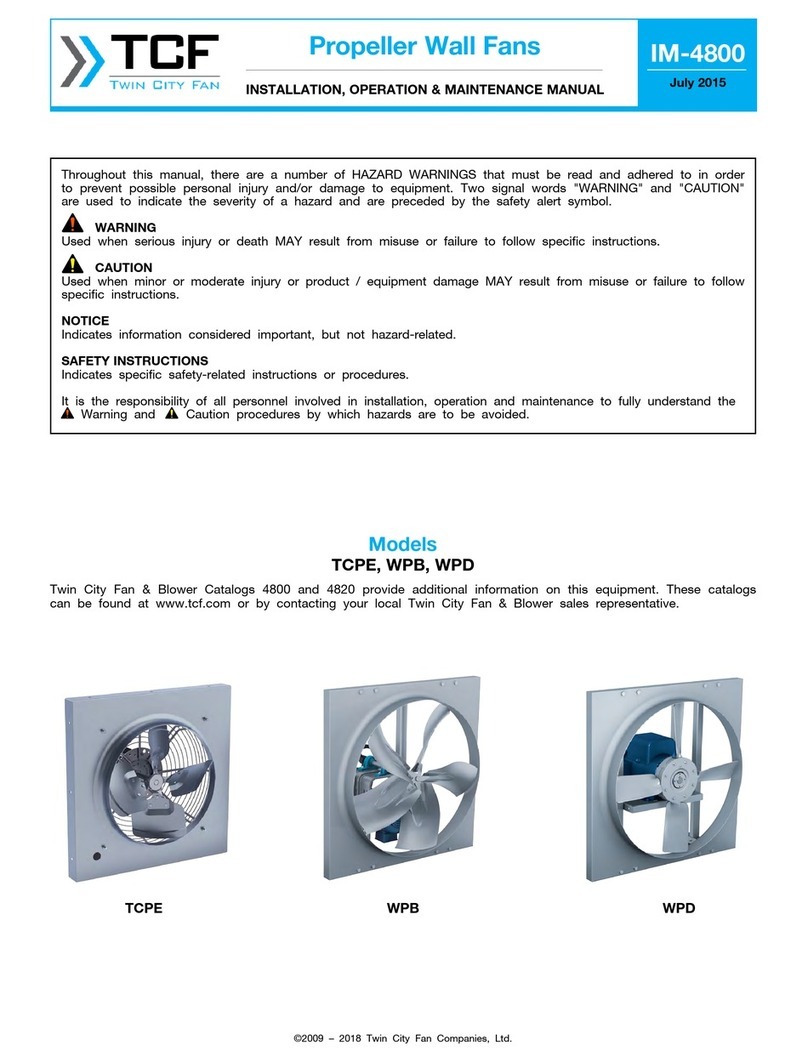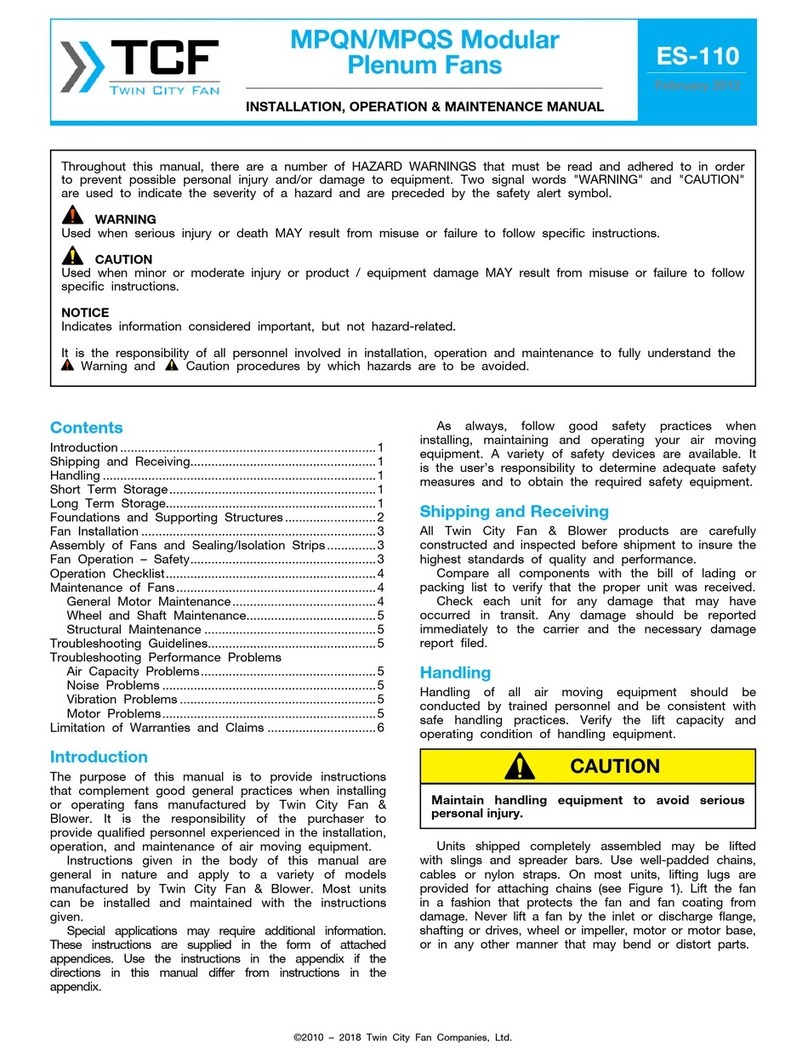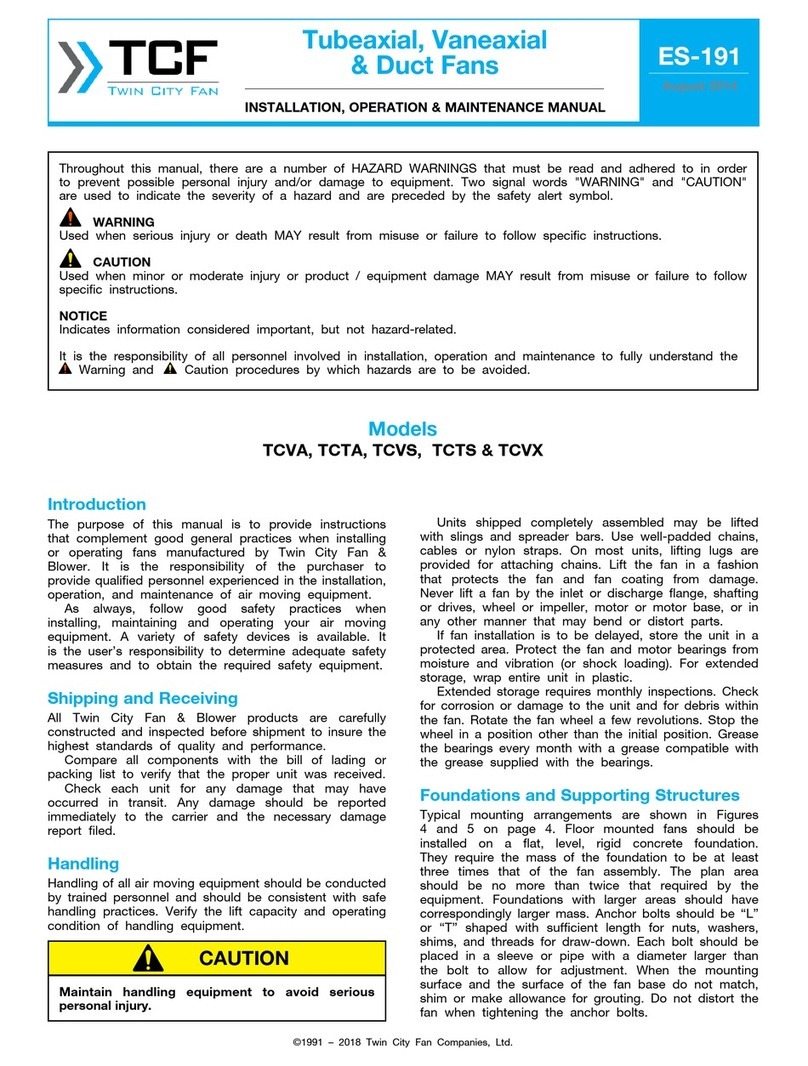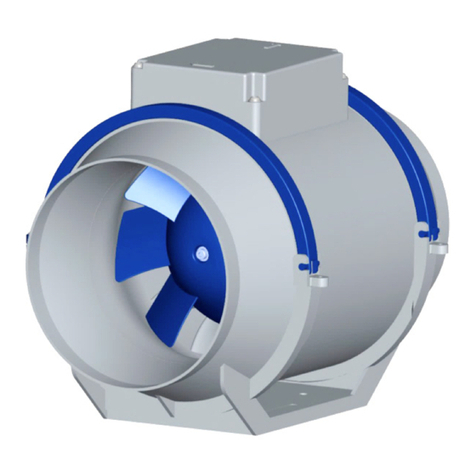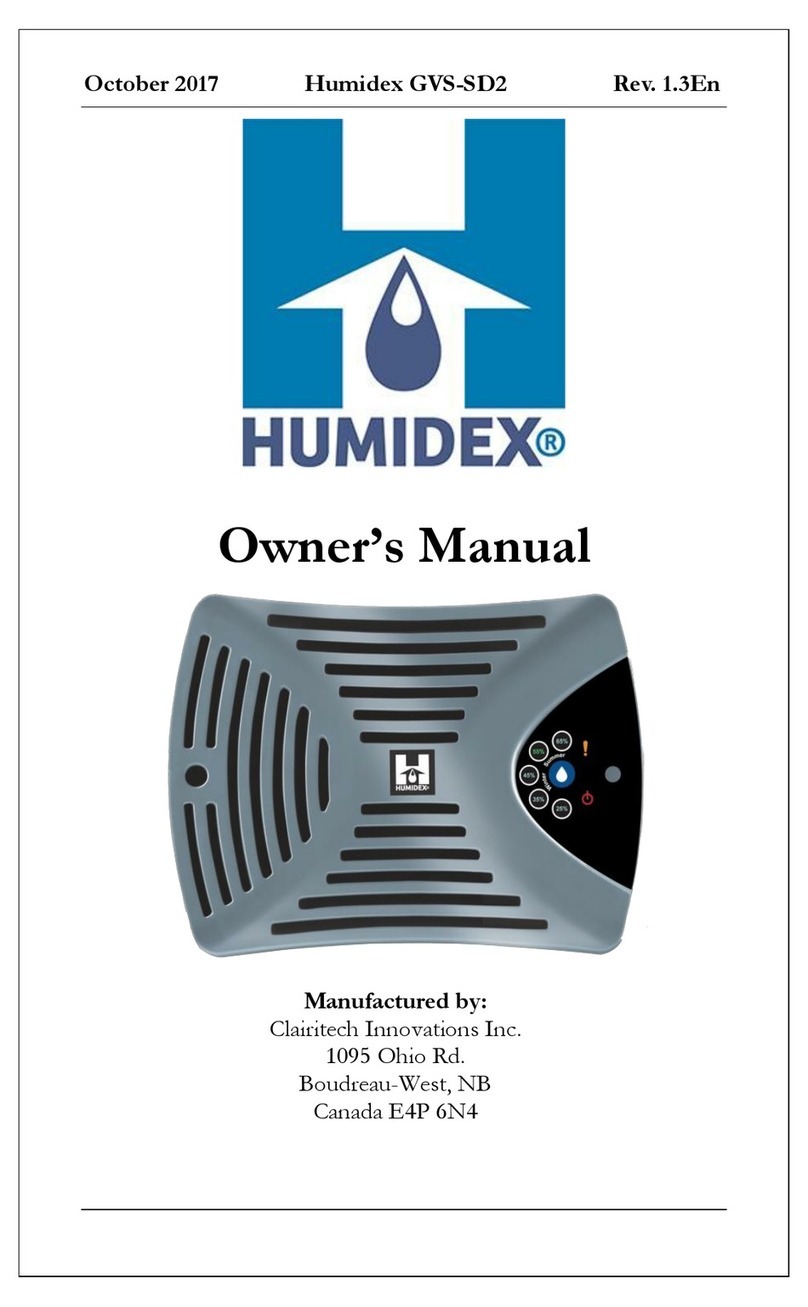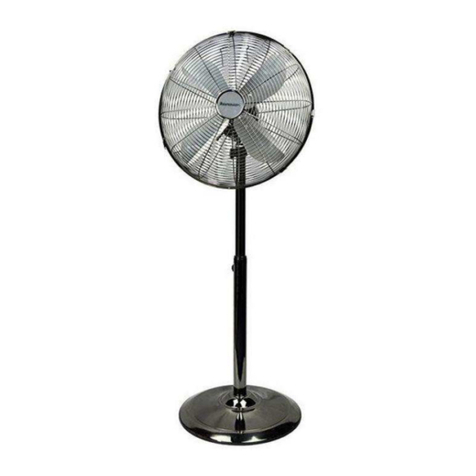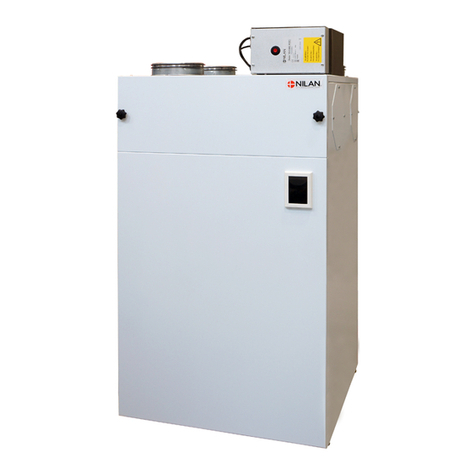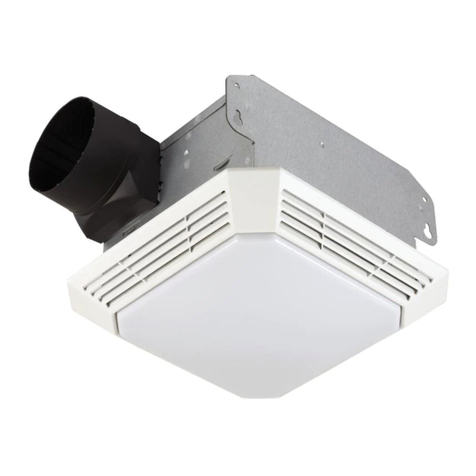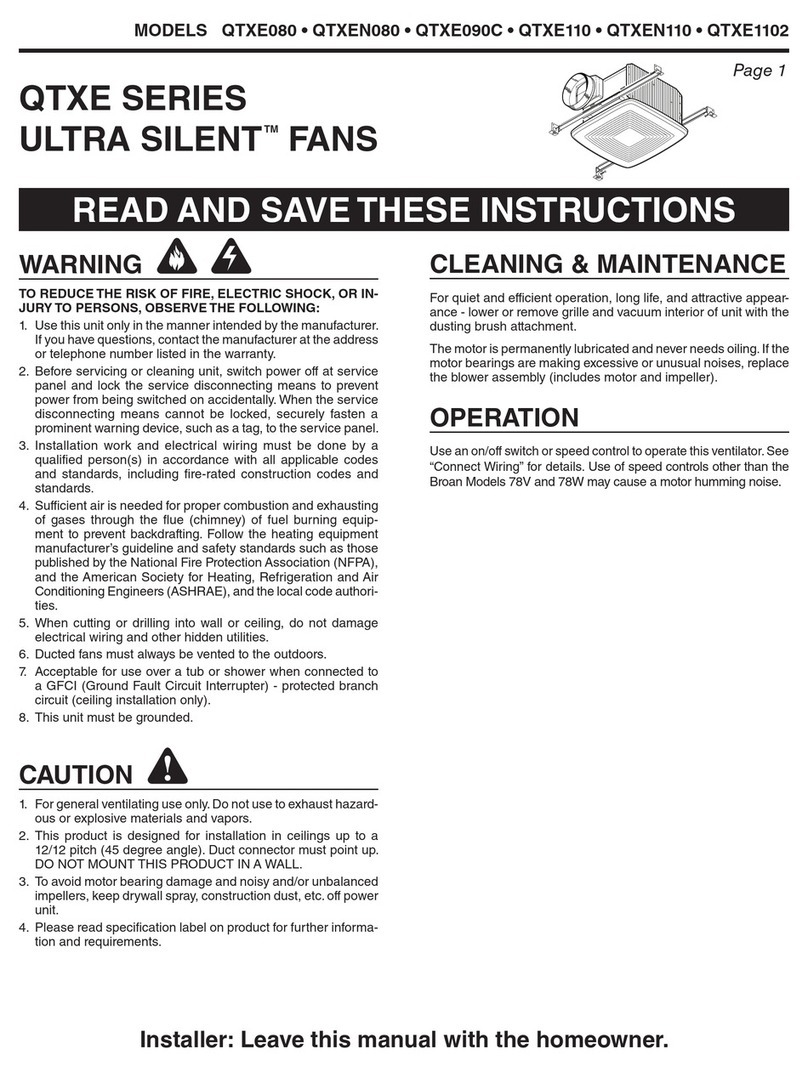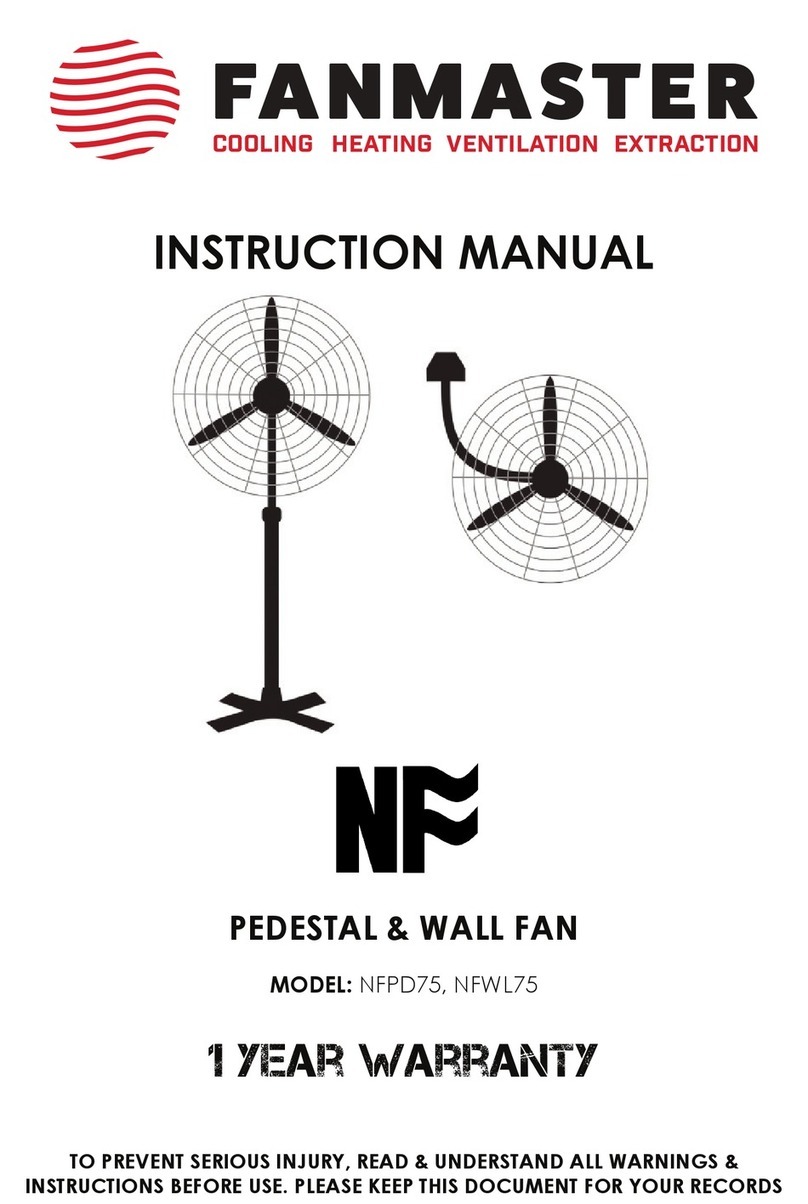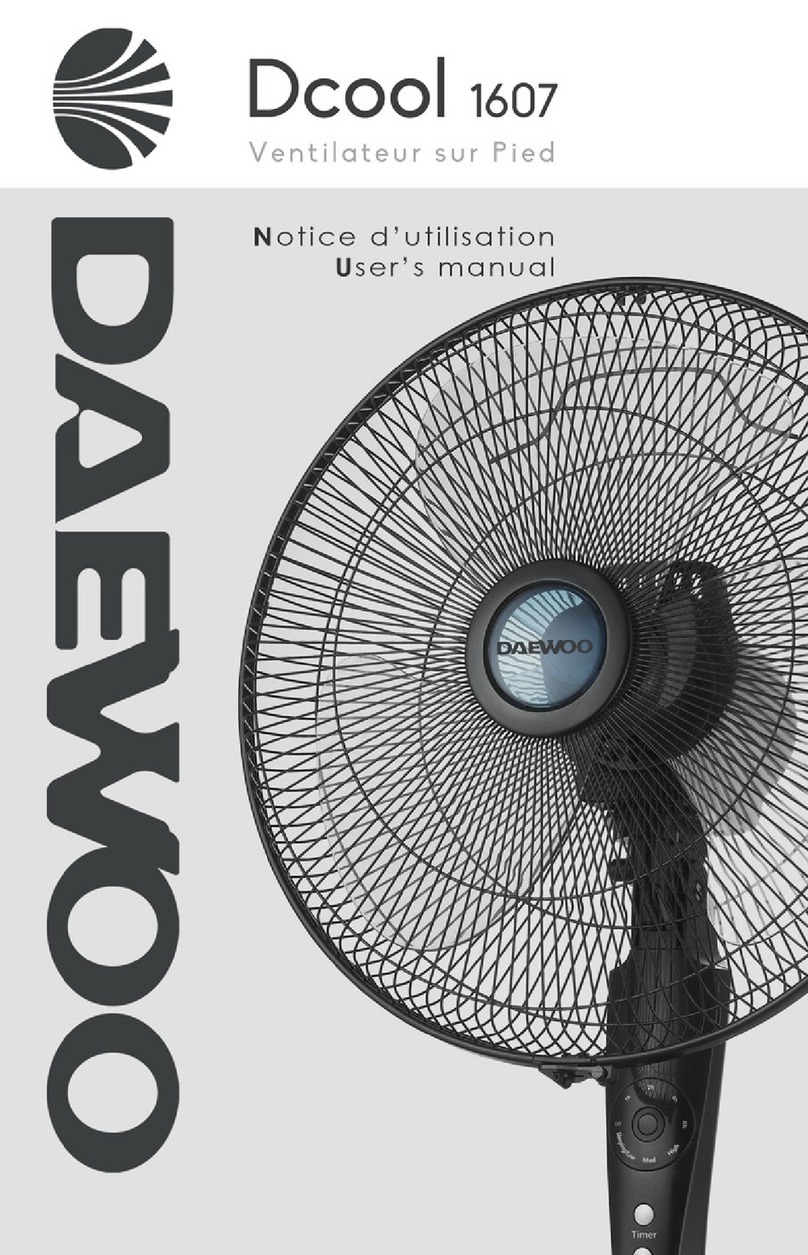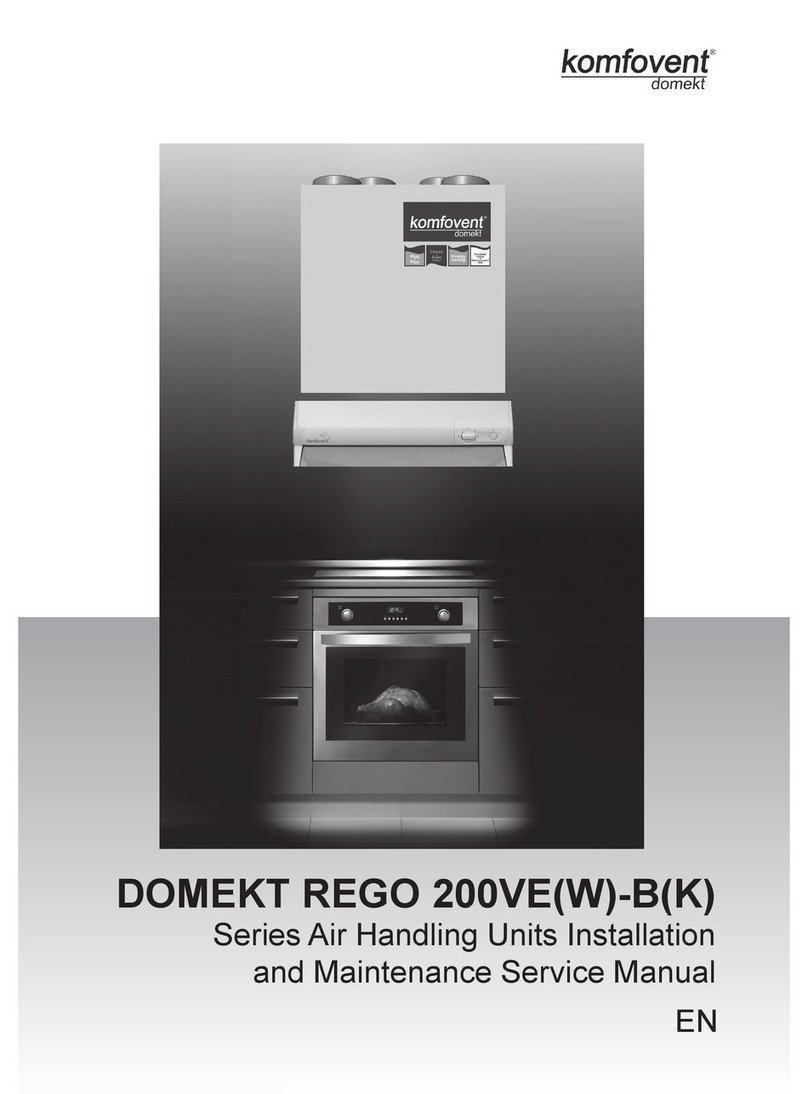TCF IM-995 Instruction manual

Centrifugal Fans
IM-995
SEPTEMBER 2023 Installation, Operation & Maintenance Manual
This manual has been prepared to guide the users of industrial centrifugal fans in the proper installation, operation and maintenance
procedures to ensure maximum equipment life with trouble-free operation. For safe installation, startup and operational life of this
equipment, it is important that all involved with the equipment be well versed in proper fan safety practices and read this manual.
It is the user’s responsibility to make sure that all requirements of good safety practices and any applicable safety codes are strictly
adhered to. Because of the wide variety of equipment covered in this manual, the instructions given here are general in nature.
Additional product and engineering information is available at www.tcf.com.
REVIEW AMCA PUBLICATION 410 PRIOR TO INSTALLATION
Table of Contents
Overview of Centrifugal Fan Arrangements ................................2
Exploded Views ............................................................................3
Impeller Nomenclature................................................................3
.............................................4
Safety & Hazard Warnings ...........................................................5
Shipping & Receiving....................................................................5
Handling .......................................................................................6
Unit Storage .................................................................................7
......................................8
...................................9
.... 10-11
....................................................................12
.................................13
..........................................................................14
Flexible Couplings ......................................................................15
..............................................................................16
...................................................................16
.....................................................................16
..........................................................17
...............................................17
.............................................................17
.......................................................................17
............................................................ 18-21
.....................................................................................22
Serial Number & Fan Type Nameplate ......................................22
Impeller Placement / Impeller Overlap ............................... 23-28
.......................................................29
..................................................30
.................................................................31
Refer to the safety section(s) in this manual prior to installing or servicing the fan. The most current version of this installation and maintenance
manual can be found on our website at www.tcf.com/resources/im-manuals.
SAFETY NOTICE
Twin City Fan

IM-995
Installation, Operation & Maintenance Manual
2
Centrifugal Fan Arrangements - Single Width, Single Inlet (SWSI)
Arrangement 4S
Arrangement 8
Arrangement 7SI
Arrangement 4VI
Arrangement 7
Arrangement 4HI
Arrangement 10
Arrangement 9
Arrangement 9F
Arrangement 9SS
Arrangement 1
Arrangement 3
Arrangement 3F
Arrangement 3SI
Arrangement 4
Arrangement 9H
Arrangement 9ST
Centrifugal Fan Arrangements - Double Width, Double Inlet (DWDI)
Arrangement 3
Arrangement 3F
Arrangement 3DI
Arrangement 7
Arrangement 7DI

Installation, Operation & Maintenance Manual
IM-995
3
Inlet Funnel Impeller
Housing
Pedestal
Inlet Collar
Sheave/Pulley
Shaft
Bearings
Motor Slide
Base
Motor
Belt
Outlet Flange
Access Hole For
Mounting Bolts
Exploded View - Centrifugal Fans
Flanged
Inlet
Impeller Front Plate
(End Ring, Shroud)
Back Plate
Blade
Support Gusset
(Spider)
Back Plate
(End Ring/RIM)
Front Plate
(End Ring/RIM)
Blade
Impeller Nomenclature

IM-995
Installation, Operation & Maintenance Manual
4
SWSI Impeller Types
Forward CurvedBackward Inclined
DWDI Impeller Types
SWSI Centrifugal Fans
AIRFLOW
AIRFLOW
Impeller Rotation
CLOCKWISE (CW)
example shown
Rotation View From Drive Side
DWDI Centrifugal Fans
Airfoil
BAE-SW
BAF-SW
BAFF
BAV
HAF
BAIFE
Airfoil
Radial
Tip
RTF
HRT
Radial
Bladed
RBOF
RBA
RBO
RBP
RBR
RBW
JRW
TBNA
TBNS
TBA
TBR
HRS
HRO
PBW
TPB
HPF
CIW
Backward
Curved
BEPL
BFPL
BCN
BCS
BCSF
HIB
Backward
Inclined
BC-SW
BCIFE
BCPL
BCV
BCVR
BCVSH
TCBI
Forward
Curved
FCV
LPSF
NFC-SW

Installation, Operation & Maintenance Manual
IM-995
5
Safety & Hazard Warnings
safety devices is the responsibility of the purchaser.
Facility related safety conditions include fans’ accessibility and location. How easily can non-service personnel access the unit? Is the
fan in a hazardous duty environment? Was the unit ordered for this duty? Other concerns must also be addressed. All fans should be
powered through controls that are easily accessible to service personnel from the fan. Fan power must have the ability to be “locked
If you have any doubt about your ability to perform a task, seek a person qualified to do that task. Before any work is done on a fan,
ensure that the fan is isolated from the electrical supply using a 'lockout/tagout system.'
Note: A stationary, non-rotating fan does not mean that the fan is isolated from the electrical supply or from other fans/dampers in the
system that could cause the fan impeller to rotate. A non-rotating fan could be subject to controls or other circuit protection devices
that may start the fan without notice.
The following safety precautions should be followed, where applicable:
injury could result from an attempt to stop it. It is recommended that the impeller is isolated by closing off the inlet or outlet to
prevent wind-driven rotation. If an impeller is chocked to prevent rotation, ensure that the chocks are removed prior to start up.
• Wear appropriate personal protective equipment. This may include protective clothing, eye protection, ear protection, respiratory
equipment, hand and foot protection when installing or servicing the fan.
• Always use caution when entering a fan's air path. High velocity airflow can cause you to lose your balance.
• Fans are often used to move hazardous materials that could be dangerous. Always wear protective clothing and take precautions
not to inhale dust/gases. If hazardous chemical vapors are present, respiratory equipment may be required.
• Sharp edges – wear protective gloves when handling, installing or servicing a fan.
• Fans can operate at high decibel sound levels. Wear proper ear protection to protect from excessive noise levels.
• When working around pulleys and belts, keep hands away from pinch points. This pertains to when the fan is under or off power.
personal injury and/or damage to equipment. Two signal words "WARNING" and "CAUTION" are used to indicate the severity of a
hazard and are preceded by the safety alert symbol. It is the responsibility of all personnel involved in installation, operation and
maintenance to fully understand the warning and caution procedures by which hazards are to be avoided.
WARNING:
CAUTION:
specific instructions.
NOTICE: Indicates information considered important, but not hazard-related.
Shipping & Receiving
All Twin City Fan & Blower products are carefully constructed and inspected before shipment to insure the highest standards of quality
and performance. Compare all components with the bill of lading or packing list to verify that the proper unit was received. Check each
unit for any damage that may have occurred in transit. Any damage should be reported immediately to the carrier and the necessary

IM-995
Installation, Operation & Maintenance Manual
6
Handling
Handling of all air moving equipment should be conducted by trained personnel and be consistent with safe handling practices. Verify
the lift capacity and operating condition of handling equipment. When using hoisting equipment, only qualified and trained personnel
should operate the equipment.
Units shipped completely assembled may be lifted with slings and spreader bars. (Use well-padded chains, cables or nylon straps,
fan by the inlet or discharge flange, shafting or drives, impeller, motor or motor base, or in any other manner that may bend or distort
parts. Never lift with slings or timbers passed through the fan inlets.
For fans provided without lifting lugs, use a forklift or pallet jack to handle the equipment. Consult a qualified person before lifting.
Lift fans mounted to a
Unitary Base as shown
Lifting lugs are provided on most units.
1. Maintain handling equipment to avoid serious personal injury and do not stand under
the load.
2. If supplied, only use the provided lifting lugs to lift the equipment.
3. Ensure that the lifting equipment is rated for the capacity to be lifted.
CAUTION
Partial or disassembled units require special handling. All parts should be handled in a method that protects the coatings and parts
from damage. Components should be handled such that forces are not concentrated to avoid bending or distortion.
when lifting.
The shaft and impeller assembly may be lifted using a hoist and a spreader with slings around the shaft at either side of the impeller.
Use the spreader bar to ensure that the slings do not push against the sides of the impeller as this may distort the impeller. Take care
not to damage the shaft where the impeller or bearings will be mounted. Never lift or support the assembly by the impeller. Always
shaft or the impeller on the housing sides. See the Fan Installation section for additional details.
Impellers shipped separately can be lifted by slings running between the blades or through the hub. Never lift the impeller by a single
the impeller as this can damage coatings and change the balance of the impeller.
Bent shafting is a source of vibration and bearing failure, so be sure
to handle the shaft with care. If the shaft is bent, replace the shaft.
Any scratches on the shaft may be repaired with fine emery cloth
or a stone. Remove only the displaced metal that forms a high
point at the edge of the scratch.
1. Bearing pedestals should be lifted using straps or padded
chains. Under no circumstance should an attached or separated
bearing pedestal be lifted by the shaft, bearings, drives, motor
or impeller.
2. Note some rotor assemblies may have an off-center CoG and
therefore a qualified person should be consulted before lifting.
CAUTION

Installation, Operation & Maintenance Manual
IM-995
7
Unit Storage
external sources or bearing damage may occur. The unit should be reasonably protected from any accidental impacts. Cover the fan
to protect coatings and to prevent any foreign material or moisture from entering the bearings, motor, inlet or discharge. Take care to
protect the motor, drives and bearings.
Extended storage requires monthly inspections. Check for corrosion or damage to the unit and for debris within the fan.
Bearings tend to take on moisture if the atmosphere in which they are stored is not at a constant temperature. To avoid corrosion, it is
necessary to keep the bearings full of grease and to rotate them periodically. Even when full of grease, bearings will take on moisture,
so it is necessary to purge the bearings with new grease to expel moisture every thirty days. It is recommended that the bearings
roller bearings with split pillow block housings must be opened up and grease removed before start-up. Remove old/excess grease
and regrease the bearing in accordance with the bearing manufacturer's instructions.
The drives and belts should be removed if the fan is to be stored for a prolonged period. The drives should be labeled for service and
stored in a dry place. Belts should be removed, coiled without kinks, placed in a heavy carton and stored in a dry, well-ventilated place.
To prevent belt deterioration storage conditions should not exceed 85°F and 70% humidity. If belts show signs of deterioration, they
should be replaced prior to startup.
around the motor. The winding temperature should be kept slightly above that of the surroundings to prevent condensation. This can
be accomplished by energizing the internal heaters, if the motor is so equipped, or by using space heaters. If it is impossible to heat
the windings, the motor should be wrapped tightly with a waterproof material that also encloses several bags of desiccant. Replace
bearing parts are well greased. Shafts on motors equipped with shaft grounding rings must remain rust free. Failure to do so renders
detail on motor storage and start up after longer periods of storage. It may be necessary to regrease the bearings. If the fan's bearings
or motor bearings have extended lubrication lines, it will be necessary to replace the grease by detaching from the motor/bearing
and purging the line with new grease.
Twin City Fan

IM-995
Installation, Operation & Maintenance Manual
8
Foundations & Supporting Structures (refer to lifting/safety section)
The best means of floor mounting a fan is on a well-designed, flat, level and prepared concrete foundation. The foundation should
have a mass of at least three times that of the supported assembly. Rigid foundation stiffness must be between 1x106lbs./in. to 4x106
lbs./in. depending upon size and speed. The foundation should extend 6" beyond the outer dimensions of the fan and driver; however,
it should be no more than twice the area required for the equipment. If it is made larger, the mass should be increased accordingly
to resist rocking modes of vibration. Anchor bolts should be carefully located by a competent tradesman as impeller to inlet, bearing
location and motor location are critical to final fan alignment. J or T type anchor bolts of sufficient size should be used and should be
tied into the reinforcing bar for the foundation. Pipe sleeves may be incorporated when pouring the concrete. After the concrete is
poured, a pipe sleeve with a diameter of 2 to 212times the anchor bolt diameter should be provided around the anchor bolt for final
adjustment. The mounting surface of the foundation should be smooth for good shim contact. It may be necessary to grind high spots.
When deciding the thickness of the foundation, approximately 1" to 112" height should be allowed for shimming, grouting, leveling,
washers, nuts, etc. The above represents industry best practice. Actual foundation design should be entrusted to a qualified engineer.
Anchor bolts should be accurately placed to coincide with the predetermined fan securing holes, or the manufactured base, to ensure
Fans mounted on a sub-floor or mezzanine must have adequate stiffness or be mounted on an inertia base with springs properly
selected. An inertia base is recommended for arrangement 8 fans to ensure alignment of the rotor and drive.
If a structural steel base or platform is to be used, the structure must be designed for the weight of the fan, live loads imposed by
rotation of the rotor and driver, and any external live loads. The structure should be designed to ensure that no natural frequency
will occur within 30% of the fan speed. This is especially true if the structure supports more than one fan. Inertia bases are generally
recommended to provide adequate mass and stiffness for fan operation.
distorted. The fan frame can be designed to carry some external loads. Consult the factory if this is a concern. Isolating the fan from
ductwork with flex connections eliminates transmission of vibration. Fans handling hot gases require expansion joints at both the inlet
and discharge to prevent excessive loads caused by thermal growth.
Fan mounted on an inertia base.
Base and pedestal shown filled with reinforced concrete.
WARNING
Refer to handling section prior to lifting equipment.

Installation, Operation & Maintenance Manual
IM-995
9
Fan Installation – Factory Assembled Units (refer to lifting/safety section)
All fan impellers are statically and dynamically balanced using state of the art equipment in the factory. Final trim balancing is
performed on factory assembled fans, unless the specified electrical characteristics of the motor are outside the limits of the factory
test equipment. If the motor and drives are supplied, the complete assembly is run tested and balanced. Infrequently, fans are
supplied with unusual electrical characteristics and cannot be tested with the motor. In this situation the fans are run and balanced
using a factory driver. Likewise, if motors and/or drives are not supplied, the fan is tested with the factory driver. Final balancing, at
the buyer’s expense, should be performed in the field after the motor and/or drives are installed. This service is available from TCF,
otherwise this should be entrusted to a qualified technician.
Follow proper handling instructions as given earlier.
1.
2. Remove skid, crates and packing materials carefully.
3. If vibration isolation is to be used, place isolation base on
mounting bolts. Line up holes in fan base with bolts. See Item
10 in the "Optional Accessories" section for preparing inertia
bases for use.
4. Place the fan on mounting structure. Carefully level the unit
as necessary using stainless steel shims on both sides of each
anchor bolt. Back off leveling nuts if used. Be careful not to
force the fan to the mounting structure/foundation. This may
cause the bearings to become misaligned or pinched causing
vibration and premature failure.
5. Check the alignment of the bearings. Shim or reposition the
bearings if necessary.
6. Check alignment of sheaves on belt driven fans.
7. Check tension of belts to see if it is sufficient. Sheaves on
belt driven fans are often provided with taper lock bushings.
When tightening bushing bolts, proceed in a progressive
manner to avoid cocking the tapered surfaces between the
bushing and the sheave. Torque per tables on the right.
8. Check alignment of factory mounted couplings, as they are
subject to misalignment during shipment and installation.
Realign to within 0.002" offset and parallel. Allow for
thermal growth of the motor by setting the motor 0.001"
low for each inch of shaft up to 0.005."
9. Check the tightness of the impeller on the shaft. Check the
tightness of foundation bolts, motor bolts, sheaves and
the impeller-inlet cone clearances and overlap are correct.
10. Check that bearings are fully lubricated and check the
oil level in the static oil lube systems. For spherical roller
bearings with split pillow block housings, the bottom half
of the housings should be 1/3 full of grease. For oil lube
bearings, the oil level should reach the midpoint of the
bottom roller or ball.
11. Install any accessories shipped loose from the factory.
The above torque values are for nonlubricated fasteners and Browning
Bushings. For bearing set screws, use manufacturer’s recommendations.
If other bushings are used, utilize bushing manufacturer's specifications.
Tolerance: +/- 5%
For impeller set screws use Grade 2 values.
SIZE
FASTENER - TIGHTENING TORQUE (Ft. Lbs.)
GRADE 2 GRADE 5 GRADE 8
#10 — — —
14-20 5.5 8 12
516-18 11 17 25
38-16 22 30 45
716-14 30 50 70
12-13 55 75 110
916-12 — — —
58-11 100 150 220
34-10 170 270 380
78-9 165 430 600
1-8 250 645 900
114-7 500 1120 1500
SIZE
TAPER BUSHINGS - TIGHTENING TORQUE (Ft. Lbs.)
SPLIT QD
FOR DRIVE
IN IRON IN ALUM. HUB
#10 — — 6
14-20 7.9 7.5 9
516-18 16 13 15
38-16 29 24 30
716-14 — — —
12-13 70 — 60
916-12 — — 75
58-11 140 112 135
34-10 — — —
78-9 — — —
1-8 — — —
114-7 — — —
Tightening Torque
Carefully level the fan on the foundation
Click To View Our
Sheave Installation video
NOTICE
Most couplings need lubrication.

IM-995
Installation, Operation & Maintenance Manual
10
Fan Installation – Disassembled Units With Split Housings
(refer to lifting/safety section)
A unit is considered “disassembled” if any component required for proper operation is shipped or supplied separately or in pieces.
Reference earlier instructions concerning proper handling of fan components and general safety. Impeller rotation is important.
Rotation is viewed from the drive side unless otherwise noted on the drawing.
All units where assembly of the fan housing or bearing pedestal or drive stand is required will have tags or matchmarks on adjacent
parts. These are used to identify which components are joined together. Units that require extensive assembly may require additional
instructions located in other sections of this manual. Special instructions for some components and accessories are sent with the
shipment.
1.
2. Remove skids, crates and packing materials carefully.
3. If vibration isolation is to be used, place the vibration isolation base on mounting bolts. Line up holes in fan base with bolts. See
Item 10 in the "Optional Accessories" section for preparing inertia bases for use.
4. Place the lower housing on the mounting structure. Carefully level the lower housing on the foundation and shim as necessary
using stainless steel shims on both sides of each anchor bolt. IMPORTANT: Back off leveling nuts if used.
5.
d. Check the bearing centerline height. Adjust the height to match centerline height of the housing. High temperature units may
require a lower housing centerline/inlet when cold so that it will be centered when hot.
e. Bring the bearing pedestal into square with the housing using careful measurements or a large square.
f. Shim and bolt the pedestal into position.
Pie Split
Housing
3-Way Split
Housing
Horizontal Split
Housing

Installation, Operation & Maintenance Manual
IM-995
11
Fan Installation – Disassembled Units With Split Housings (Cont.)
(refer to lifting/safety section)
6. If the impeller and shaft were shipped unassembled, you must now install the shaft in the impeller.
a. First use solvent to clean the protective coating off the shaft. Check all surfaces for corrosion or nicks and clean if necessary with
fine emery cloth or a stone. After thoroughly cleaning the shaft with solvent, do not touch it with bare hands as perspiration can
cause rust or pitting over time.
b. Remove keys from the shaft.
impeller bore.
d. Insert the shaft into the impeller from the back side of the impeller.
impeller set screws.
f. For Arrangement 3 fans, refer to the drawing for appropriate impeller and shaft dimensional relationship.
g. Check the assembly drawing to make sure that the impeller and shaft have been assembled correctly.
7. The rotor can now be installed in the housing. Slide the bearings on if they are solid
pillow blocks or loosely mount the bottom halves if they are split. Inlet vanes and/or inlet
funnels may need to be installed over the shaft before installing and bolting the bearings
Insert the inlets into the impeller inlet and tie them off
for lifting and placing in the housing. Refer to steps 8 and 9 for order of assembly of
components for double width and single width fans. The shaft should be cleaned and
oiled where it will contact the bearings. Carefully lower the shaft assembly into the
bearings. Use care when lowering the shaft onto the bearings so thrust bearings, collars
and liners are not damaged due to misalignment. The bearing housing should be parallel
to the axis of the shaft to prevent loads caused by misalignment. Precision shim bearings
thermal growth. Refer to bearing installation instructions in this installation manual.
housing. Center impeller in funnels.
b. Assemble parts in above order on shaft.
c. Proceed with connection of the shaft assembly to supports in step 7 above.
bar assembly to housing. Refer to the impeller-funnel overlap section.
a. Assemble parts in above order on shaft.
b. Proceed with connection of the shaft assembly to supports in step 7.
10.Install motor on the base if applicable. Carefully align shafts for drive installation. After the fan is leveled, prior to grouting, back
off leveling nuts if used.
Click To View Our
Rotor Installation/Removal Video
Click To View Our
Impeller Installation/Removal Video
Twin City Fan

IM-995
Installation, Operation & Maintenance Manual
12
Bearing Installation (refer to safety section)
The following section gives some general instructions on bearing installation. If bearings are to be field installed, the specific
installation manual for the bearings will be provided and should be followed carefully. If provided, check the assembly drawings
and bearing manufacturer's instructions for location of the fixed and expansion bearings. The positions of these bearings cannot be
interchanged. Always follow the bearing manufacturer's instructions.
Solid Pillow Block
1. Lightly lubricate the bearing bore and slide bearing into the proper position on the
shaft. Sling the rotor assembly into place and loosely bolt the bearings in place.
2. When bearings are in place, shim appropriately and torque the base bolts using values
from the Tightening Torque table on page 9. Tighten the collar set screws to manufacturer’s
specification. The set screws on both bearings should be aligned with one another. If the
bearing has an adapter mount, hand tighten the locknut to establish the “zero” point.
Next, tighten the number of turns per the instructions furnished with the bearing. Rotate
by hand to be sure the bearings and shaft rotate freely.
3. Ensure the expansion bearing is centered within its housing. If bearings need to forced
onto the shaft then apply force on the inner race/collar only (does not apply to adapter
until the fixed bearing has been bolted and locked. After locking the expansion bearing to
the shaft, position the pillow block to allow for axial expansion, approximately centered
in the pillow block, then bolt to the pedestal.
4. Unless the user orders differently, bearings are lubricated in the factory with a lithium
complex, NLGI grade 2 grease. Refer to the bearing lubrication schedule on the next
page.
Spherical Roller Bearings with Split Pillow Block Housings
1. The bearings should be disassembled, taking care not to interchange parts between
bearings. Tops of housings are not interchangeable with the bottom half pillow block
from another bearing. Pins locate the top half of the housing to prevent it from being
installed in the reverse.
2. The lower bearing housing should be bolted loosely to the pedestal and seals; bearing
and adapter sleeve should be placed loosely on the shaft.
3. The rotor assembly with the seals and bearings should next be positioned over the
housings and carefully placed into the lower housings.
4. The stabilizing ring, sometimes referred to as the “C” ring, is installed in the bearing closest to the drive sheave or coupling
unless otherwise noted in the drawing. The bearing race should be centered in the expansion bearing. The exception may be on
Arrangement 3 or 7 fans with a high operating temperature. Refer to the fan drawing for location. The “C” ring is not used in the
expansion bearing.
5. When installing adapter sleeves, tighten for reduction in clearance per manufacturer’s instructions.
6. Bend down a tab on the lockwasher after finishing adjustment. Some brands of bearings do not utilize a lockwasher. Instead you will
find allen-head set screws in the locknut outside diameter. Tighten the set screw after reduction in clearance is attained.
7. Grease or oil according to manufacturer’s instructions. Grease/lube will likely include the partial fill of the housing internal cavities.
8. Install the bearing housing cap bolts and bearing mounting bolts. Tighten bearing housing cap bolts and bearing mounting bolts. Torque
to bearing manufacturer's instructions.
Sleeve Bearings
1. The bearings should be disassembled and cleaned with appropriate solvent, taking care not to interchange parts between bearings.
Parts of one bearing are generally not interchangeable with parts from another bearing. Bearing caps are matched to the bottom
half of the pillow block and are not interchangeable with other pillow blocks.
2. The lower bearing housings should be bolted loosely to the pedestal. The lower liner should then be placed in the housing.
3. Oil the lower liners per manufacturer’s instructions and carefully sling the rotor assembly into place, being very careful not to
damage the bearing liners.
4. Install thrust collars and thrust plates in the fixed bearing
5.
6. When handling the liners, be careful not to damage the surfaces, as they are babbitted and are fragile.
7. The housings are generally tapped with a number of ports. Be sure the oil level gauge, circulating oil supply and discharge,
thermocouples, etc., are correctly placed for accessibility.
8.
9.
instructions are shipped with the fan. Instructions can also be found on the bearing manufacturer’s website.
Split Pillow Block Bearings
Solid Pillow Block Bearings

Installation, Operation & Maintenance Manual
IM-995
13
Safety & Bearing Lubrication Instructions
*Suggested lubrication interval under continuous operation in adverse loading or with
elevated temperatures. For operation less than 24 hours per day or under ideal conditions,
lubrication frequency may be reduced. Relubricate while running, if safety permits, until
some purging occurs at seals. Adjust lubrication frequency depending on condition of
purged grease. Hours of operation, temperature and surrounding conditions will affect the
relubrication frequency required.
1. Lubricate with a high quality NLGI No. 2 lithium-base grease having rust inhibitors and
greases having these properties are:
2. Lubricate bearings prior to extended shutdown or storage and rotate shaft monthly
to aid corrosion protection.
3. Any lubrication requirements noted on the general assembly drawing supersede
requirements found here.
Fans with Unit Roller Bearings
Relubrication Schedule (Weeks)*
Spherical Roller Bearing - Solid Pillow Blocks
Shaft DIA Speed (RPM)
500 1000 1500 2000 2500 3000 3500 4000 4500
1⁄2" thru 17⁄16"
(13 – 35) 644211110.5
111⁄16" thru 23⁄16"
(40 – 55) 4 2 1.5 1 0.5 0.5 0.5 0.5 0.5
27⁄16" thru 37⁄16"
(60 – 85) 3 1.5 1 0.5 0.5 0.25 0.5 – –
315⁄16" thru 415⁄16"
(100 – 125) 2.5 1 0.5 0.25 – – – – –
*Suggested lubrication interval under continuous operation in adverse loading or with
elevated temperatures. For operation less than 24 hours per day or under ideal conditions,
lubrication frequency may be reduced. Relubricate while running, if safety permits, until
some purging occurs at seals. Adjust lubrication frequency depending on condition of
purged grease. Hours of operation, temperature and surrounding conditions will affect the
relubrication frequency required.
1. Lubricate with a high quality NLGI No. 2 lithium-base grease having rust inhibitors and
greases having these properties are:
2. Lubricate bearings prior to extended shutdown or storage and rotate shaft monthly to
aid corrosion protection.
3. Any lubrication requirements noted on the general assembly drawing supersede
requirements found here.
Fans with Ball Bearings
Relubrication Schedule (Weeks)*
Ball Bearing Pillow Blocks
Shaft DIA Speed (RPM)
500 1000 1500 2000 2500 3000 3500 4000 4500
1⁄2" thru 111⁄16"
(13 – 45) 665332221
115⁄16" thru 27⁄16"
(50 – 60) 654221111
211⁄16" thru 215⁄16"
(65 – 75) 5432111––
37⁄16" thru 315⁄16"
(90 – 100) 4 3 2 1 1 – – – –
*Suggested lubrication interval under continuous operation in adverse loading or
with elevated temperatures. For operation less than 24 hours per day or under ideal
conditions, lubrication frequency may be reduced. Relubricate while running, if safety
permits, until some purging occurs at seals. Adjust lubrication frequency depending on
condition of purged grease. Hours of operation, temperature and surrounding conditions
will affect the relubrication frequency required.
1. Lubricate with a high quality NLGI No. 2 lithium-base grease having rust inhibitors
Some greases having these properties are:
2. Lubricate bearings prior to extended shutdown or storage and rotate shaft monthly
to aid corrosion protection.
3. Purge or remove old grease when changing lubrication brands or types.
4. Any lubrication requirements noted on the general assembly drawing supersede
requirements found here.
Static Oil Lubrication
1. Use only high quality mineral oil with a VG grade indicated on the customer
submittal drawing.
3. Complete lubrication change should be made annually.
Fans with Spherical Roller Bearings
with Split Pillow Block Housings
Relubrication Schedule (Weeks)*
Spherical Roller Bearing - Split Pillow Blocks
Grease to
be added
at each
interval
Shaft DIA Speed (RPM)
500 750 1000 1500 2000 2500 3000 3500 4000
17⁄16" thru 115⁄16"
(35 – 50) 6 4.5 4 4 3.5 2.5 21.5 1 1 0.50 oz.
23⁄16" thru 213⁄16"
(55 – 70) 5 4.5 4 2.5 2.5 1.5 0.5 0.25 0.25 0.75 oz.
215⁄16" thru 315⁄16"
(75 – 100) 4.5 4 3.5 2.5 1.5 1 0.5 – – 2.00 oz.
47⁄16" thru 415⁄16"
(110 – 125) 4 4 2.5 1 0.5 – – – – 4.00 oz.
57⁄16" thru 615⁄16"
(140 – 180) 4 2.5 1.5 – – – – – – 8.5 oz.
WARNING
1. This equipment must not be operated without proper guarding of all moving parts. While performing maintenance be sure remote
power switches are locked off. See AMCA Publication 410 for recommended safety practices.
2. Before starting: Check all set screws for tightness and rotate impeller by hand to make sure it has not moved in transit.
Twin City Fan

IM-995
Installation, Operation & Maintenance Manual
14
Drive Mounting
(refer to safety section)
1.
evenly tightening in steps. To minimize bearing loading,
mount sheaves as close to bearings as possible. It is preferable
to use alignment tools that align the grooves of the sheave.
2. Laser alignment is common. The mechanic must be familiar
with the alignment tool he is using. Otherwise, align sheaves
with straightedge extended along sheaves, just making
contact in two places on outside perimeters of both sheaves.
This “four-point” alignment may also be checked with a
string tied to the shaft behind one of the sheaves. The string
is then pulled taut over the faces of the sheaves to check the
alignment at the four points at the outside perimeters. Each
sheave should be rotated about one-half revolution during
this check to look for excessive runout or a bent shaft. Unless
there is a bent shaft, runout can be corrected by adjustments
to the bolt torque of the taper bushing.
3. Install and tighten the belts. Run the drive for a few minutes
to seat the belts. When fitting the belts, slide the motor in
the belt cords. Tighten the belts to the proper tension. Ideal
tension is just enough tension so that the belts do not slip
with tensioning data, which identifies the load to apply at
the center of the span and the allowable deflection from
this force. A belt tension gauge is recommended for precise
tensioning.
4. After initial installation of belts, recheck belt tension again
after a few days of operation to adjust belt tension. (New
Placing fan sheave on motor can overspeed impeller and cause
structural failure.
CAUTION
WARNING
When working around belts and pulleys, keep hands away from
pinch points.
Click To View Our
Sheave Installation video
Twin City Fan

Installation, Operation & Maintenance Manual
IM-995
15
Flexible Couplings (refer to safety section)
These instructions are general for the installation of several types of flexible couplings and should not be used as a substitute for more
specific manufacturer’s instructions. The coupling manufacturer’s installation data is available and will give specific dimensions for
alignment limits, lubricants, etc. Refer to Item 8 in "Factory Assembled Units" section for coupling alignment requirements.
Before preparing to mount the coupling, make sure that all bearings, inlet vanes, shaft seals or other components have been installed
on the shaft.
When mounting and keying the coupling halves to the shaft, follow supplied instructions for heating and shrink fitting. Set the coupling
halves for the normal gap specified by the manufacturer. Coupling gap is illustrated below. It is advisable to set the motor on the
pedestal first to better determine the placement of the coupling on the shaft.
ANGULAR PARALLEL GAP AND
MISALIGNMENT MISALIGNMENT END FLOAT
*
The two types of misalignment are illustrated above. Alternatively angular alignment is checked with feeler gauges between the
hub faces. When angular alignment has been adjusted to manufacturer’s specification, parallel alignment can be checked with a dial
within specification, angular alignment and gap should again be checked, and adjustments made if necessary. A dial indicator or laser
alignment may be used to more accurately take the measurements described above.
Special adjustments may need to be made for couplings used with some equipment. As an example, when used with motors with
requiring the driver side to be set slightly low when not operating. A good rule of thumb is to set the motor low by 0.001 inches per
inch of motor shaft diameter up to 0.005". Refer to specific instruction manuals or assembly drawings.
Thoroughly clean the coupling halves after completion of alignment. Reassemble the coupling and tighten bolts, washers and locknuts.
Lubricate per manufacturer’s recommendations.
2. End float will allow for thermal movement
3. Limited end float couplings are often required in applications using motors with sleeve bearings
*

IM-995
Installation, Operation & Maintenance Manual
16
Maintenance (refer to safety section)
observations of sound and vibration will help prolong the life of the fan. If changes are noted check bolt tightness, foundation integrity,
cleanliness of the impeller and or motor, bearing lubrication and drive components. Always keep records of the maintenance that is
performed.
Drive Maintenance (refer to safety section)
V-belt drives need periodic inspection, retensioning and occasional belt
replacement. When inspecting drives, look for dirt buildup, burrs or obstructions
that can cause premature belt or drive replacement. If burrs are found, use fine
emery cloth or a stone to remove them. Be careful that dust does not enter the
bearings.
Check sheaves for wear. Excessive slippage of belts on sheaves can cause wear and vibration. Replace worn sheaves with new ones.
Carefully align sheaves to avoid premature sheave failure. If fraying or other wear is observed to be mostly on one side of the belts,
When replacing belts, replace the entire set. Never use belt dressing on any belts, as it may cause belt wear.
Motor Maintenance
The three basic rules of motor maintenance are:
1. Keep the motor clean.
2. Keep the motor dry.
3. Keep the motor properly lubricated.
motor from overheating.
Some smaller motors are lubricated for life. Lubrication requirements are normally attached to the motor. Use the motor manufacturer’s
recommendations for relubrication. Often motor lubricants are not the same as the fan bearings. If this information is not available,
inspection for wear and shaft corrosion is recommended. Replace the ring if it is making minimal contact with the shaft. If corrosion
is present, treat the shaft with colloidal silver per the ring manufacturer's instructions.
WARNING
When working around belts and pulleys, keep
hands away from pinch points.
1. Swingout fans should be opened for impeller cleaning and
inspection only and should be closed immediately after
cleaning. Isolate from the electrical supply before opening.
2. Do not run swingout fans the fan in the open position.
CAUTION
Motors Less than 10HP
Running 8 Hrs/Day
(clean environments)
Motors Between
15-40HP
(clean environments)
Motors Running 24/7
or if in dirty/dusty
environments
Lube every 5 years Lube every 3 years
interval by 4
Motor Lubrication Schedule
Do not over lubricate.

Installation, Operation & Maintenance Manual
IM-995
17
Fan Bearing Maintenance (refer to safety section)
Proper lubrication of the fan drive bearings helps assure maximum bearing life. All fans are equipped with decals indicating the
recommended relubrication intervals for normal operating conditions. Refer to the Bearing Installation section for the lubrication
schedules for ball bearings, solid pillow block spherical roller bearings and split pillow block spherical roller bearings. Note that all
speeds shown do not apply to all shaft sizes in that group. Consult the factory if in doubt of maximum speed for a particular bearing.
Note that every installation is different and the frequency of relubrication should be adjusted accordingly.
Use 1/2 to 1/3 of the listed lubrication interval for high moisture applications. For vertical shaft mounts or dirty conditions use 1/2
the lubrication schedule.
Observation of the conditions of the grease expelled from unit ball or roller bearings at the time of relubrication is the best guide
as to whether regreasing intervals and amount of grease added should be altered. Spherical roller bearings with split pillow block
housings should not be lubricated until grease purges or overheating may result. Follow the lubrication interval and amount noted in
the Bearing Installation section. Spherical roller bearings with split pillow block housings should be serviced once per year. Remove
cap, clean out old grease and replace by filling the bottom half of the housing 1/3 full.
Greases are made with different bases. There are base greases, lithium base, sodium base, polyurea, etc. Avoid mixing greases with
different bases. They could be incompatible and result in rapid deterioration or breakdown of the grease. The lubrication sticker
identifies a list of acceptable lubricants. All bearings are filled with a lithium complex grease before leaving the factory. When the fans
discharge because leakage will cease when the excess grease has worked out. Sometimes the bearings have a tendency to run hotter
during this period. This is no reason for alarm unless it lasts over 48 hours or temperatures exceed 200°F. When relubricating, use a
sufficient amount of grease to purge the seals. Rotate bearings by hand during relubrication. If extended lubrication lines are fitted,
lubricate the bearings while the fan is operating if it is safe to do so.
Impeller and Shaft Maintenance (refer to safety section)
Periodically inspect the shaft and impeller for dirt buildup, corrosion and signs of excess stress or fatigue. Clean the components. If
the impeller is removed for any reason, make sure that it is securely attached to the shaft before restarting the fan.
Structural Maintenance (refer to safety section)
All structural components or devices used to support or attach the fan to a structure should be checked at regular intervals. Vibration
isolators, bolts, foundations, etc., are all subject to failure from corrosion, erosion and other causes. Improper mounting can lead to
poor operation characteristics or fan fatigue and failure. Check metallic components for corrosion, cracks or other signs of stress.
Concrete should be checked to insure the structural integrity of the foundation.
Duct Connections
(refer to safety section)
The fan support structure is normally not designed to carry
loads imposed by the weight of ducts, silencers, stacks, etc.
Supporting these loads on the fan can cause housing distortion
and may cause performance or vibration problems. Use of
flexible connections is recommended for all fans and imperative
when using vibration isolation or handling high temperature
gases.
Centrifugal Fan with
Vibration Isolation & Flexible
Duct Connectors

IM-995
Installation, Operation & Maintenance Manual
18
Optional Accessories
1. Turning Gear — A turning gear is sometimes used in high temperature applications where the fan is exposed to high temperature
gases when not in operation. The impeller and shaft can expand unevenly due to the temperature when sitting idle, which can
cause vibration at startup and/or a permanent set to the rotor. The turning gear slowly turns the fan from the outboard side
while it is not operating, providing for even thermal expansion. It starts automatically when the fan shuts down and disengages
2. Shaft Seals — The standard shaft seal is a wire inserted fiberglass
tacky cloth element retained with an aluminum retaining plate and
clips. Other configurations of shaft seals are available for special
applications, such as when it is necessary to keep the shaft seal as
gas tight as possible. Shaft seal application manuals are provided in
Fan Engineering FE-700 available on www.tcf.com. Other seals such
as stuffing boxes, mechanical seals and carbon ring seals need special
attention. It is imperative that after the fan has been leveled, shimmed,
fastened to the foundation and ducted the shaft and seal be checked
for concentricity and angularity. The seal must not bind when the shaft
is rotated. Stuffing box packing material must not be compressed too
period of time. Connect a purge if specified. Carbon ring seals have pins
that prevent ring rotation.
3. Variable Inlet Vanes — Variable inlet vanes are provided as assemblies
internally in the inlet cone or externally in a flanged cylinder. The
vanes are used to control volume and save power in installations
where different volumetric operating conditions are used. Installation
manuals are provided in other engineering supplements for specific fan
types. Variable inlet vanes may be provided with powered operators in
which case the manufacturer’s installation and operating manuals will
be provided. Inlet vanes are unidirectional. Vanes should be stroked
periodically to prevent binding and possible seizure. Note: The weight
of customer supplied vanes may need to be supported indepently of the
fan. Consult with Twin City Fan.
4. Inlet Box and Inlet Box Dampers — Inlet boxes may be provided to
allow transition from a duct to the fan inlet. Inlet box dampers may also
are usually provided as a complete assembly and are installed with
the damper axles parallel to the fan shaft. They should be installed
if the fan is operated regularly with damper settings less than 30%
open. Operation below 30% should be limited to start-up or occasional
periods of low duration.
Orientation of Damper Blades Relative to Fan Rotation
Orientation of Inlet Vanes Relative to Fan Rotation

Installation, Operation & Maintenance Manual
IM-995
19
Optional Accessories (cont.)
5. Outlet Dampers — Outlet dampers are usually provided
completely assembled like the inlet dampers. The damper is
bolted to the fan discharge for volume control.
6. Shaft Cooler — Also referred to as “heat slingers” or “cooling
impellers,” these are small, radially bladed aluminum
impellers that are split and bolted for installation between
the inboard bearing and fan housing. The cooling fins face
the bearing for grease applications and away from the
bearing for oil applications to prevent oil from being drawn
out of the bearing.
7. Anti-Rotation Clutch
operated in the wrong rotation. Run the motor uncoupled
from the fan to establish the proper rotation.
8. Oil Lubrication:
Static Oil – Warning: Some fans are supplied with oil lubricated
anti-friction bearings due to customer preference. Some fans
are supplied with oil as the fan speed exceeds that which
is acceptable for grease. Consult with the factory before
changing lubrication from oil to grease.
a. Use non-detergent turbine oil specified on the fan's
general assembly drawing.
b. Oil level should be half way up the bottom rolling element.
If leakage occurs, lower the oil level by 2-3 mm.
c. A breather should be used to equalize pressure, which
reduces oil leakage.
d. If a heat slinger is supplied, place vanes facing away from
the bearing to prevent oil from being drawn out of the
bearing.
e. Change oil regularly if automatic oilers are not being used.
Oil condition depends upon operating temperature, hours
of operation, moisture, environmental cleanliness and
overall vibration. Start at three month intervals and adjust
interval based on the condition of the used oil. Clean the
breather at this time.
f. If removing the bearing cap, prior to reinstalling, clean
the splits and apply a thin coat of Permatex in order to
minimize leakage.
g. Set up automatic lubricators according to instructions
supplied with the fan.
h. Prior to start-up, be sure that the oil has been heated to a
minimum of approximately 50° F.
Static Oil
Lubrication System

IM-995
Installation, Operation & Maintenance Manual
20
Optional Accessories (cont.)
Oil Circulation Systems:
a. Use non-detergent, turbine grade oil specified on the general accessory drawing.
b. Utilize the drain ports specified on the general accessory drawing.
c. There must be a slope of 15 degrees or ½" slope per foot to effectively drain the bearing and minimize leakage.
e. Piping must be flushed to leave no residue on a 20 micron filter.
f. Return piping should be heat traced to maintain flow in cold conditions.
i. If a heat slinger is supplied, place vanes facing away from the bearing to prevent oil from being drawn out of the bearing.
leakage. Oil flow rate is found on the general assembly drawing.
9. Site-Feed Oilers — Fans provided with optional, site-feed oilers, the oil level is to be set as indicated by the manufacturer’s
installation instructions provided with the fan.
10. Concrete Filled Bases:
Inertia Bases
instructions are a guide for filling a base with concrete. Remember to use safe practices when filling concrete into the base. It is
best to fill concrete at or near the base’s final resting area to reduce injury while transferring to the permanent location. The surface
of the concrete must be to the height of the top of the isolation base, +0.06" or - 0.125", so the pedestal can set on the isolation
base with proper support. The mounting surface at the top of the base should be kept clean to ensure secure fastening between
the base and the bottom of the fan.
An inertia base is supplied with steel mesh or rebar added within the base frame with the intent of being filled with concrete and
When an optional bottom pan is supplied from the factory, the base must be set on a flat, level surface with the bottom pan
directly on the surface fully supporting the pan to maintain flatness on the bottom side. Pour concrete into the base and remove
excess concrete on the top side of the base to maintain an even mounting surface for fan mounting. Be sure that the concrete
has cured before lifting the base. Install isolators per the isolator installation manual.
When the optional bottom pan is not supplied, the base must be set on a flat, level surface that can fully support the weight of
the concrete. Place a sheet of heavy-mil poly-film between the flat surface and the base frame. Pour concrete into the base and
remove excess concrete on the top side of the base to maintain an even mounting surface for fan mounting. Be sure that the
concrete has cured before lifting the base. Install isolators per the isolator installation manual.
Optional Bottom Pan
Plastic Sheeting
Click To View Our
Inertia Base Installation Video
Table of contents
Other TCF Fan manuals
Popular Fan manuals by other brands
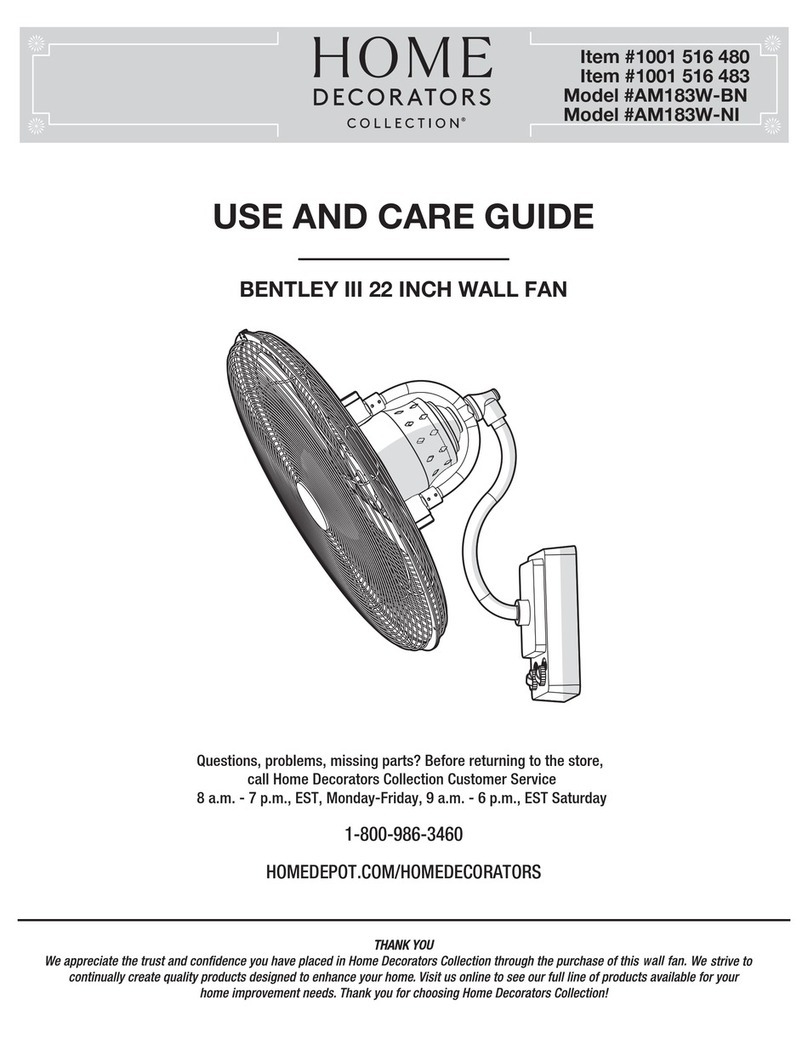
Home Decorators Collection
Home Decorators Collection AM183W-NI Use and care guide
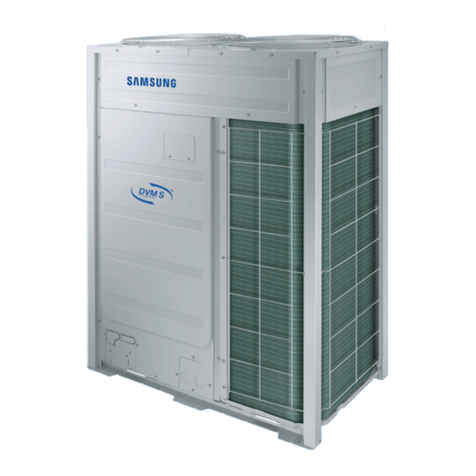
Samsung
Samsung VRF DVM S Water Technical data book
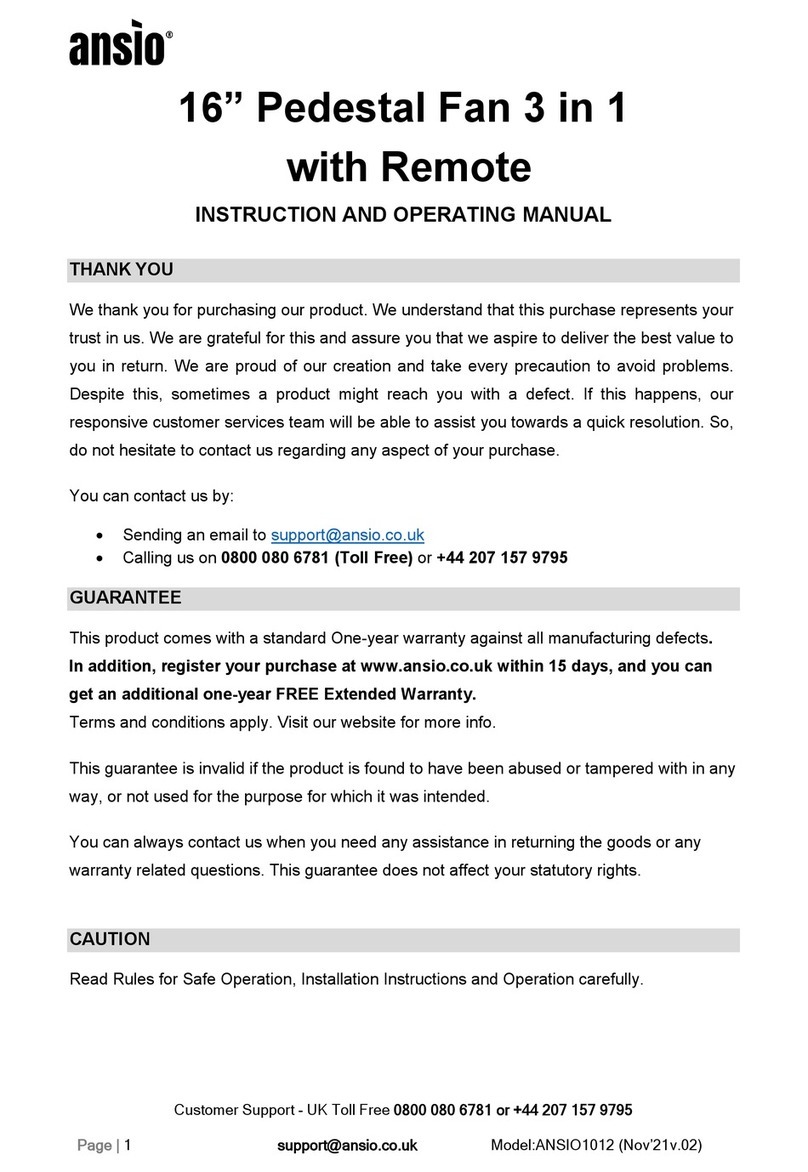
ansio
ansio ANSIO1012 Instructions and operating manual
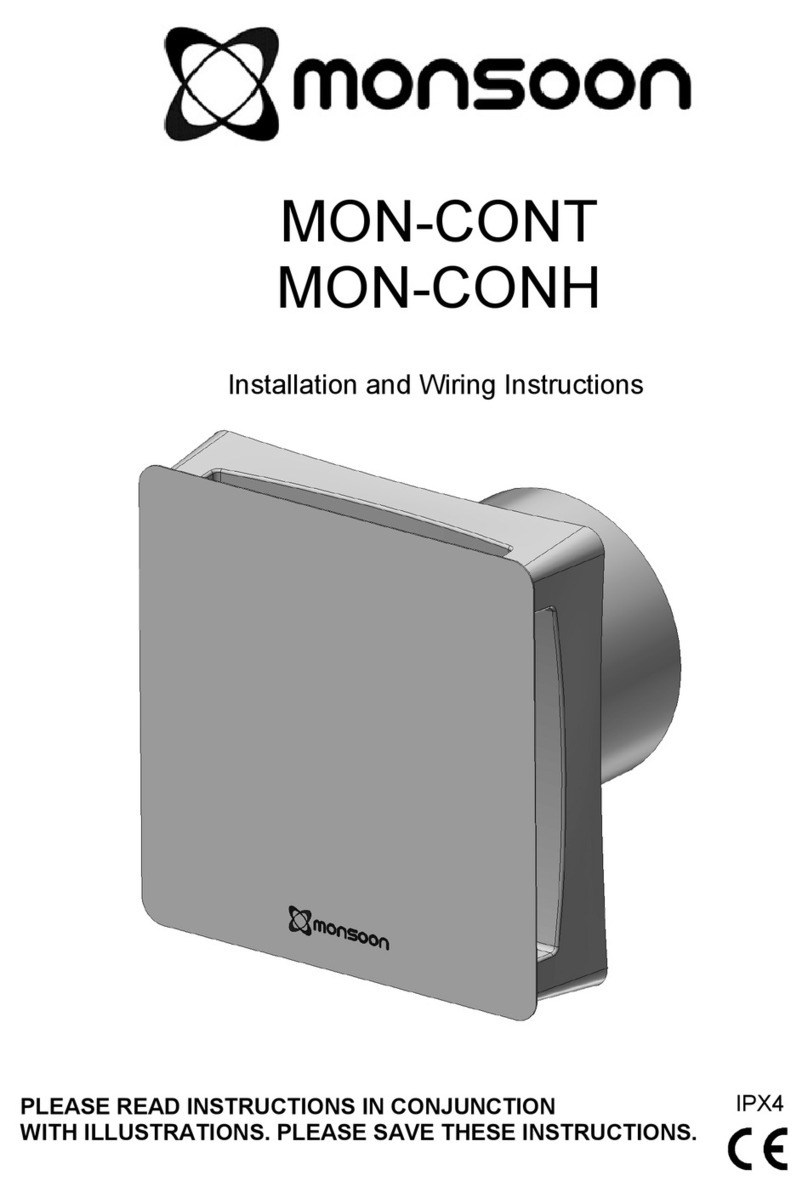
Monsoon
Monsoon MON-CONT Installation and wiring instructions
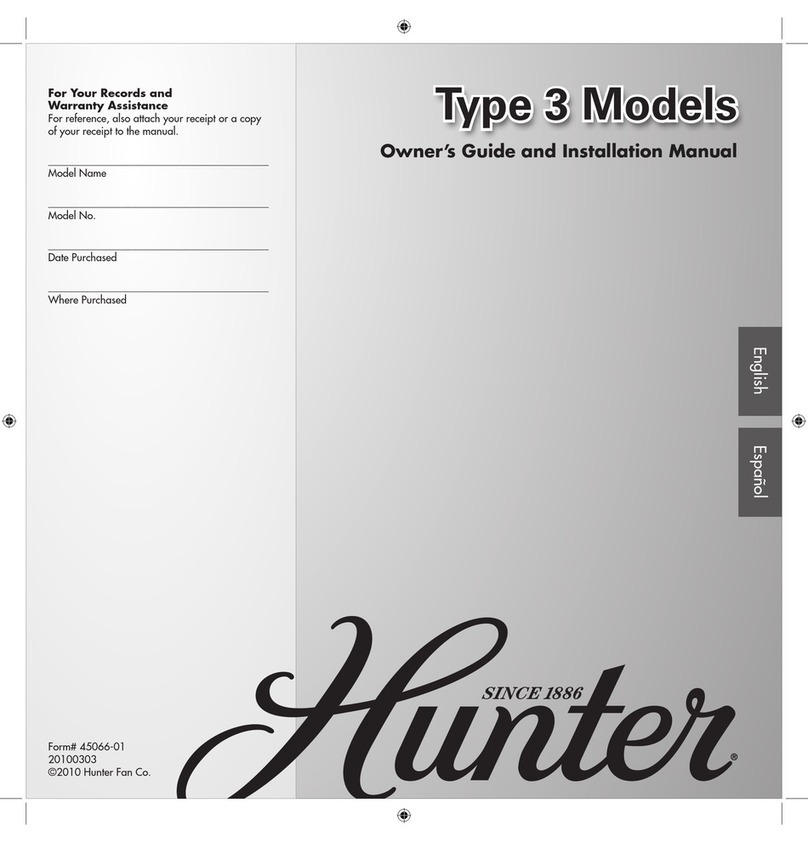
Hunter
Hunter Type 3 Models Owners and installation manual
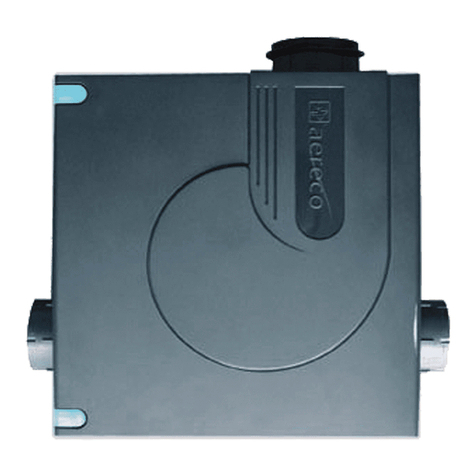
Aereco
Aereco V2A installation instructions
